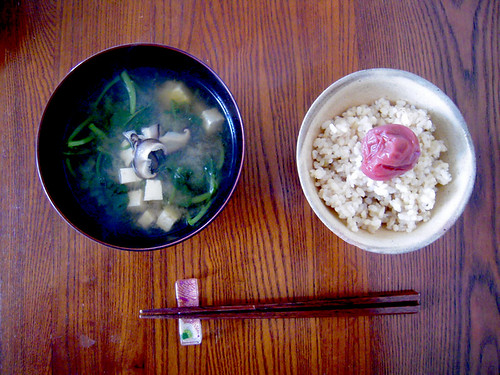
Last month, I took a relaxing trip to Pt. Reyes with one of the best books I have read this year, the
Omnivore's Dilemma by Michael Pollan (
The Girl with the Dragon Tattoo was another one of my favorites this year). Although I felt like I kind of knew what Pollan's
deal was from hearsay, I fully understood the logic and practicality of his views by actually reading his book - packed with clear and often, hilarious prose.
What does this have to do with making miso soup? Well, I am huge fan of American cereal and a huge fan of the simple,
Japanese breakfast. After reading the Omnivore's Dilemma though, I noticed I was slowly phasing out the former from my diet. The fact that cereal is mostly comprised of processed grains and corn, I was beginning to feel that it was a bit overpriced for what it was-- without giving me the benefits of a miso soup-based breakfast which is doesn't leave me feeling overly stuffed and then really hungry barely an hour later.
The beauty of miso soup is that you can pretty much throw in any kind of left-over leafy greens to give you a great start to your day.
So let's get to making the actual miso soup, using the dashi from
my post last week.
1. Put three cups of dashi in a pot. If you use wakame, make sure to soak the wakame in some water for at least 10 minutes, while you heat up the dashi. I like to experiment and my latest favorite wakame substitute is watercress. I just dump a handful into my dashi and heat on medium until the watercress is wilted.

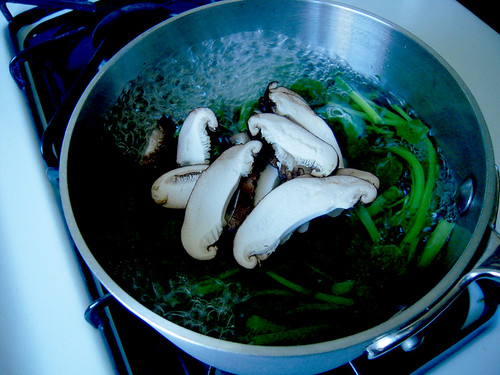
2. You can also add any other kinds of veggies that entice you (I have used Napa cabbage, regular green cabbage, broccoli, potatoes, onions, etc). I also usually slice up a shiitake and sprinkle it in.
3. Bring down the heat to low. Cube tofu and add into mixture.
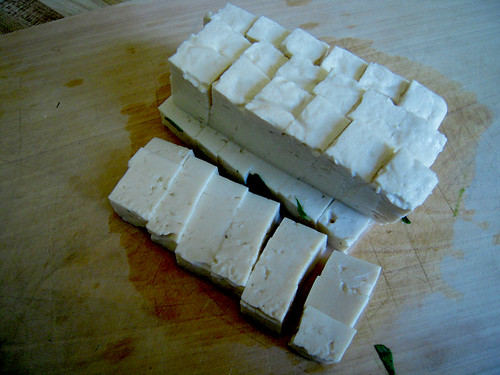
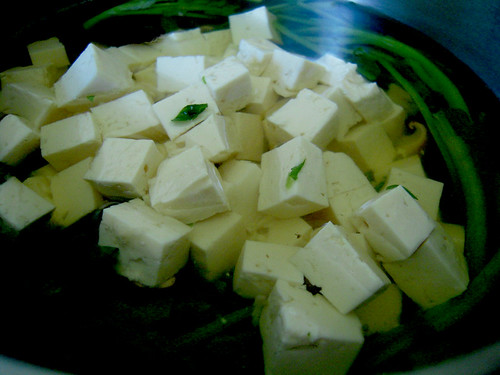
4. Make sure that the soup is not rolling - you may even have to turn off the heat.
5. Add about two tablespoons of miso slowly into the liquid. Make sure the miso doesn't clump up by either straining the miso into the liquid or slowly melting the miso into the liquid by breaking it up with chopsticks.
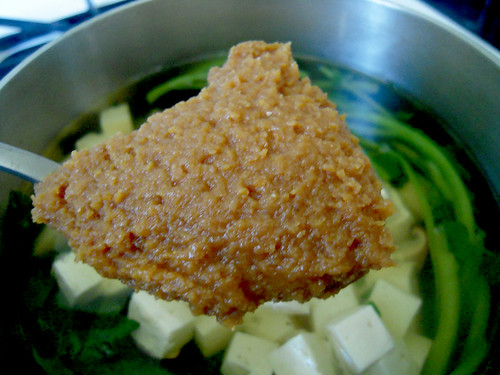
6. Turn off the heat if it isn't already off.
7. Ladle soup into bowls. Bowls should preferably have lids and they should be capped when served.
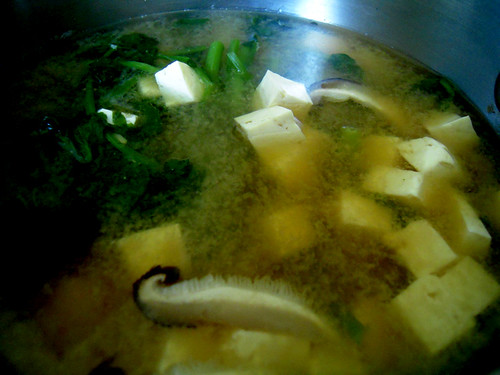
8. The point of a lidded bowl is that when the eater opens the lid, a waft of the miso soup's blissful, aroma will fill his/her nasal passages. Its lid will also keep the soup warm and lock in the flavor.
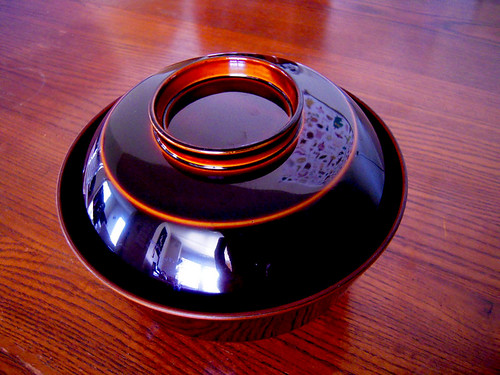
In a nut shell, miso soup is just about cooking some veggies in dashi, adding some tofu and adding the miso into the mixture in the end right before serving. Once you get the the hang of it, it can be ready in 10 minutes.
This is my typical breakfast nowadays.
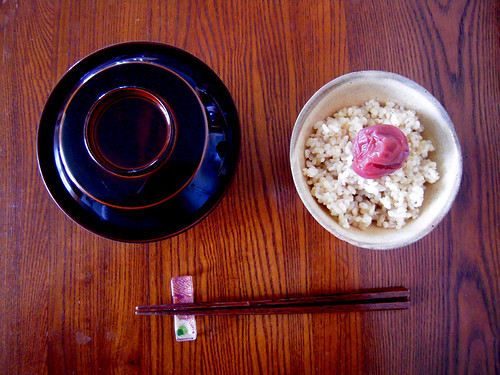

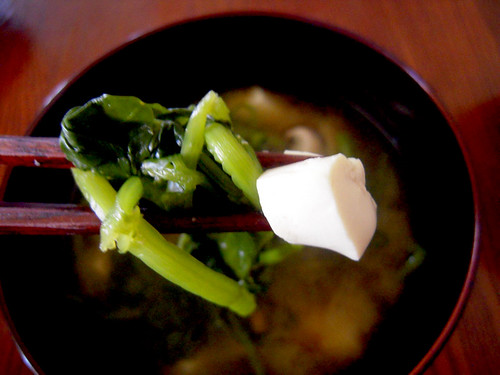
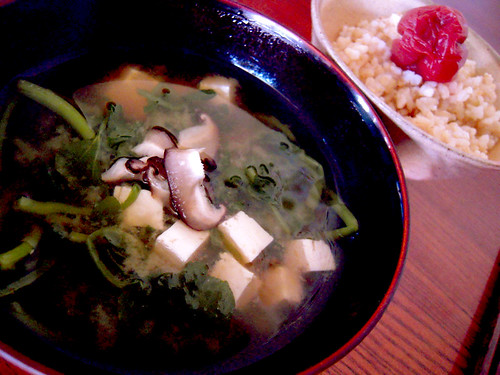
I have to say, I don't miss my cereal one bit... yet.
 Last month, I took a relaxing trip to Pt. Reyes with one of the best books I have read this year, the Omnivore's Dilemma by Michael Pollan (The Girl with the Dragon Tattoo was another one of my favorites this year). Although I felt like I kind of knew what Pollan's deal was from hearsay, I fully understood the logic and practicality of his views by actually reading his book - packed with clear and often, hilarious prose.
What does this have to do with making miso soup? Well, I am huge fan of American cereal and a huge fan of the simple, Japanese breakfast. After reading the Omnivore's Dilemma though, I noticed I was slowly phasing out the former from my diet. The fact that cereal is mostly comprised of processed grains and corn, I was beginning to feel that it was a bit overpriced for what it was-- without giving me the benefits of a miso soup-based breakfast which is doesn't leave me feeling overly stuffed and then really hungry barely an hour later.
The beauty of miso soup is that you can pretty much throw in any kind of left-over leafy greens to give you a great start to your day.
So let's get to making the actual miso soup, using the dashi from my post last week.
1. Put three cups of dashi in a pot. If you use wakame, make sure to soak the wakame in some water for at least 10 minutes, while you heat up the dashi. I like to experiment and my latest favorite wakame substitute is watercress. I just dump a handful into my dashi and heat on medium until the watercress is wilted.
Last month, I took a relaxing trip to Pt. Reyes with one of the best books I have read this year, the Omnivore's Dilemma by Michael Pollan (The Girl with the Dragon Tattoo was another one of my favorites this year). Although I felt like I kind of knew what Pollan's deal was from hearsay, I fully understood the logic and practicality of his views by actually reading his book - packed with clear and often, hilarious prose.
What does this have to do with making miso soup? Well, I am huge fan of American cereal and a huge fan of the simple, Japanese breakfast. After reading the Omnivore's Dilemma though, I noticed I was slowly phasing out the former from my diet. The fact that cereal is mostly comprised of processed grains and corn, I was beginning to feel that it was a bit overpriced for what it was-- without giving me the benefits of a miso soup-based breakfast which is doesn't leave me feeling overly stuffed and then really hungry barely an hour later.
The beauty of miso soup is that you can pretty much throw in any kind of left-over leafy greens to give you a great start to your day.
So let's get to making the actual miso soup, using the dashi from my post last week.
1. Put three cups of dashi in a pot. If you use wakame, make sure to soak the wakame in some water for at least 10 minutes, while you heat up the dashi. I like to experiment and my latest favorite wakame substitute is watercress. I just dump a handful into my dashi and heat on medium until the watercress is wilted.

 2. You can also add any other kinds of veggies that entice you (I have used Napa cabbage, regular green cabbage, broccoli, potatoes, onions, etc). I also usually slice up a shiitake and sprinkle it in.
3. Bring down the heat to low. Cube tofu and add into mixture.
2. You can also add any other kinds of veggies that entice you (I have used Napa cabbage, regular green cabbage, broccoli, potatoes, onions, etc). I also usually slice up a shiitake and sprinkle it in.
3. Bring down the heat to low. Cube tofu and add into mixture.

 4. Make sure that the soup is not rolling - you may even have to turn off the heat.
5. Add about two tablespoons of miso slowly into the liquid. Make sure the miso doesn't clump up by either straining the miso into the liquid or slowly melting the miso into the liquid by breaking it up with chopsticks.
4. Make sure that the soup is not rolling - you may even have to turn off the heat.
5. Add about two tablespoons of miso slowly into the liquid. Make sure the miso doesn't clump up by either straining the miso into the liquid or slowly melting the miso into the liquid by breaking it up with chopsticks.
 6. Turn off the heat if it isn't already off.
7. Ladle soup into bowls. Bowls should preferably have lids and they should be capped when served.
6. Turn off the heat if it isn't already off.
7. Ladle soup into bowls. Bowls should preferably have lids and they should be capped when served.
 8. The point of a lidded bowl is that when the eater opens the lid, a waft of the miso soup's blissful, aroma will fill his/her nasal passages. Its lid will also keep the soup warm and lock in the flavor.
8. The point of a lidded bowl is that when the eater opens the lid, a waft of the miso soup's blissful, aroma will fill his/her nasal passages. Its lid will also keep the soup warm and lock in the flavor.
 In a nut shell, miso soup is just about cooking some veggies in dashi, adding some tofu and adding the miso into the mixture in the end right before serving. Once you get the the hang of it, it can be ready in 10 minutes.
This is my typical breakfast nowadays.
In a nut shell, miso soup is just about cooking some veggies in dashi, adding some tofu and adding the miso into the mixture in the end right before serving. Once you get the the hang of it, it can be ready in 10 minutes.
This is my typical breakfast nowadays.



 I have to say, I don't miss my cereal one bit... yet.
I have to say, I don't miss my cereal one bit... yet.




Comments (9)
I LOVE miso soup!
Thanks for the reminder that my cereal sucks. =)
Cereal is definitely tempting. I still can’t shake off the allure when I am at the grocery store. Also cereal ads on TV are pretty genius and make my mouth water. Miso soup has rescued me from my cereal trance though. And I am really thankful for that.
That looks so yummy. Are you having it with brown rice? We sometimes make miso soup with aubergine (eggplant) or cabbage. I’ve never been a breakfast person, but I’ve begun to think the Japanese breakfast is probably the healthiest.
important point not to miss. Once you put miso, NEVER boil it. I have no idea why, but that’s what my mom told me.
I love that Yoko’s mouth waters when watching cereal commercials on tv. That is brilliant.
Yamahomo- my mom always yells at me for boiling miso. I think the miso maybe gets more salty as it cooks.
Sakura – Actually, I eat Haiga-mai. It’s half-milled, so that the bran (outer layer) is removed but not the germ part. Therefore, it’s not as hearty as brown rice but still preserves the healthy element.
Yes, Yamamhomo, on step number 5 I should emphasize that the reason why you don’t want it boiling and even turn off the heat is that you DON’T want to boil it ever with the miso inside.
Kayoko – You know I am a cereal fiend right?
http://www.umamimart.com/2009/04/Chocolate-Curl-Cereal-Challenge/
chiming in on why you don’t boil the miso, from my macrobiotic days- miso is filled with healthy enzymes that are killed when you boil it. you lose the substantial health benefits of miso if you do this! also the taste of the miso is less aromatic if boiled.
Question for Yoko: After your re-introducing miso soup into my daily diet, I am making this stuff daily for breakfast.
However, since the earthquake in Sendai happened the tiny Copenhagen shop carrying Japanese wares has lost its supply of pure miso, so all they have right now is miso with pre-mixed in dashi in the box… Can I just that or is that consided a no no? Boiling 3 cups of water – veggies in – add tofu – stop boiling – add miso (incl. dashi).
Other good ideas what to add in the miso soup so breakfast won’t be too repetitive?
Yeah, go ahead and use the dashi-iri stuff. You can put whatever you want in your miso soup as long as it feels right to you. I’ve put everything from potatoes, onions, green onions, carrots, gobo, spinach, wakame, tofu, kale, aburaage, etc. I can usually incorporate most of my produce into my miso soup. Efficient way to clean out the fridge.